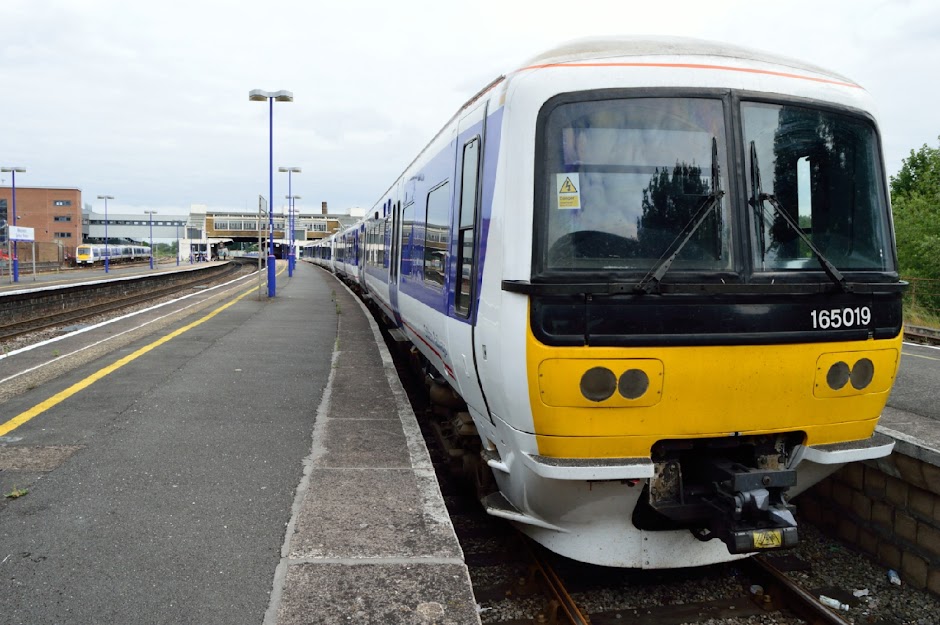Wellingborough Station In Pictures
 |
| Wellingborough Railway Station Entrance Photo: Charles Moorhen |
Grade II listed Wellingborough Wellingborough railway station on the Midland Main Line, and built by the former Midland Railway, is situated approximately one mile from Wellingborough town centre in Northamptonshire.
 |
| Wellingborough Station Platforms 1 and 2 Photo: Charles Moorhen |
Designed by architect, C.H.Driver, who was also responsible for the Sao Paulo railway station opened in 1867 in Brazil, Wellingborough railway station was opened in 1857 as a main line station - London St. Pancras is only 65 miles away - and for the branch line to nearby Higham Ferrers.
Known at the time of opening as Wellingborough Midland Road, the station originally boasted five platforms which, over the decades, has been reduced to three. Two are used by the travelling public while the other borders a freight-only line.
Platform five exists in situ but is weed-strewn and overgrown and all but one of its buildings have been demolished. Their is no public access to this platform.
It had opened in 1845 and closed completely in 1966. Sadly, nothing remains of the London Road station. It was completely obliterated by road improvements to the nearby A45.
 |
| Wellingborough Station LMS Goods Shed Diamond-Shaped Lattice Window Photo: Charles Moorhen |
 |
| Ridge and Furrow platform canopy and filigree metal work on Platform 1 (upper left) Photo: Charles Moorhen
Wellingborough Midland Road and nearby Kettering were the first two Midland Railway stations to display their impressive ridge-and-furrow metal and glass platform canopies and finely crafted filigree metalwork.
Also on platform one, at the 'London' end so to speak, stands a small Grade II listed goods shed that has survived for well over a century displaying its original lattice windows - an architectural signature of the Midland Railway.
|
(A more descriptive blog post, with photos of the shed interior and cranes, can be seen by clicking wellingborough goods shed still survives).
 |
| East Midlands Trains Class 43066 at Wellingborough Station Photo: Charles Moorhen |
On the 2nd of September 1898, around 8.22 pm , Wellingborough Midland Road railway station became a scene of carnage and tragedy.
A railway porter's trolley being used for the transportation of mail bags ran out of control, rolled off the platform and ended up on the railway tracks minutes before an express train was due to pass through.
Despite desperate attempts by station staff to remove the trolley from the path of the oncoming train, time ran out. The express collided with it at speed.
The crew of the derailed steam locomotive were killed as were five passengers when the coach they were travelling in disintegrated.
In all 65 people were also injured.
 |
| Wellingborough Station Platform 1 Photo: Charles Moorhen |
During 2005, Wellingborough station briefly basked in the glare of the movie spotlight when it featured in the film, Kinky Boots; temporarily renamed 'Northampton' for the location footage.
A British comedy-drama, the film was based on the true story of a family-run shoe factory, W.J.Brooks Ltd., of Earls Barton, Northamptonshire.
 |
| Photo: Charles Moorhen |
Commemorative plaque attached to the front wall of Wellingborough railway station.
 |
| Wellingborough Railway Station Platform 1 Photo: Charles Moorhen |
 |
| Wellingborough Station Platform Sign in front of LMS Goods Shed wall Photo: Charles Moorhen |
Don't forget to subscribe to 'Along These Tracks' railway blogt to get all new posts and updates sent directly to you.
Blog update:
Previous photo posts are now easier to find.
All blog posts are now listed alphabetically on the right side of your screen; under the heading, 'Previous Photo Posts'.
"I hope this makes your search easier".
Previous photo posts are now easier to find.
All blog posts are now listed alphabetically on the right side of your screen; under the heading, 'Previous Photo Posts'.
"I hope this makes your search easier".

















